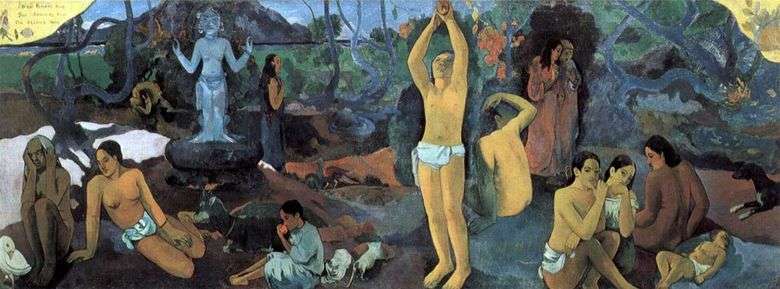
One of the most famous paintings of Paul Gauguin. Created in Tahiti, is currently in the Museum of Fine Arts in Boston, Massachusetts, USA. Gauguin went to Tahiti in 1881 in search of a society more natural and simple than his native French. In addition to several other paintings he created, which express his highly individualistic mythology, he began this picture in 1897 and graduated in 1898.
The artist himself considered the work an exalted culmination of his reflections. Keepers of the Boston Museum of Fine Arts, where the painting is now constantly changing their entry on the history of ownership of the painting as the discovery of new facts. In 1898, Gauguin sent a picture of George Daniel de Monfreyd in Paris. Then it passed and was sold to several other Parisian and European traders and collectors, until it was bought by the Gallery Mary Harriman in New York in 1936.
The Boston Museum of Fine Arts acquired it from the Gallery of Maria Harriman on April 16, 1936. The painting is exhibited in the Museum of Fine Arts in the collection of Tompkins, part of the Galleria Sidney and Esther Rabb. It is about 1.5 m tall and over 3.6 m long. Gauguin decided to commit suicide after completing this picture, which he tried to do before. He pointed out that the picture should be read from right to left – the three main groups of figures illustrate the questions posed in the title.
Three women with a child represent the beginning of life; the middle group symbolizes the daily existence of maturity; in the final group, according to the artist’s intention, “an old woman approaching death seems to be reconciled and surrendered to her reflections,” at her feet “a strange white bird… represents uselessness of words.” The blue idol in the background seems to represent what Gauguin described as “the other world.” On the completeness of the picture he said the following, “I believe that this painting not only surpasses all my previous ones, and that I will never create something better or even similar.”
The painting is key in the innovative post-impressionist style of Gauguin; his art emphasized the clear use of colors and thick strokes, the principles of impressionism, while at the same time sought to convey an emotional or expressionistic force.
 D’où venons-nous? Qui sommes nous Où allons-nous? – Paul Gauguin
D’où venons-nous? Qui sommes nous Où allons-nous? – Paul Gauguin De donde venimos Quienes somos Hacia donde vamos – Paul Gauguin
De donde venimos Quienes somos Hacia donde vamos – Paul Gauguin Are you jealous? by Paul Gauguin
Are you jealous? by Paul Gauguin When Will You Marry by Paul Gauguin
When Will You Marry by Paul Gauguin Still Life with Charles Laval’s Profile by Paul Gauguin
Still Life with Charles Laval’s Profile by Paul Gauguin Mountains in Tahiti by Paul Gauguin
Mountains in Tahiti by Paul Gauguin Riders on the shore by Paul Gauguin
Riders on the shore by Paul Gauguin Self-Portrait in a Hat by Paul Gauguin
Self-Portrait in a Hat by Paul Gauguin